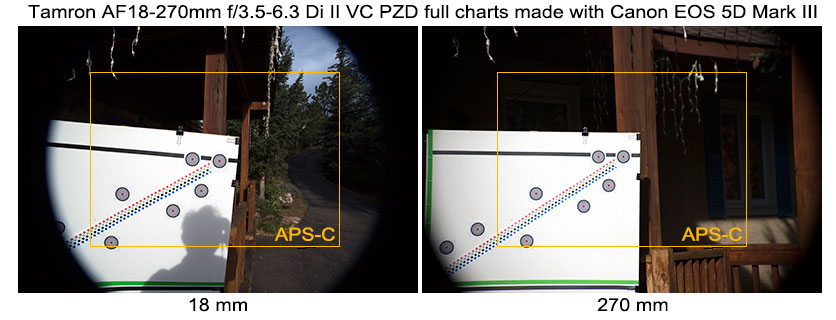Tamron Zoom Lens AF 18-270mm f/3.5-6.3 Di II VC PZD tested with EOS M
| Aperture Range [f] | 3.5-6.3 to 22-40 | Closest Focus | 0.49m / 1.6 ft. |
| Dimensions | 96mm x 74mm / 3.8 x 2.9" | Magnification Ratio | 0.26x / 1:4 |
| Weight | 450g / 19.4 oz | Filter Size | 62mm |
This is a very compact and and extreme power (15x) zoom lens that is made for APS-C sensors, 22.3x14.9mm, cameras. The tests here were made with EOS M mirrorless camera and Canon EOS 5D Mark III. It fits also a full frame cameras, but the image is smaller than the sensor (see the images on the bottom of this page). Due to it's zoom power is very versatile and attractive, especially when in travel. It focuses well, but slow, so it is generally not recommended for sports/action events, especially in low light.
Click on the "Various f-stops" thumbnail below, to see the charts made at different f stops and focal lengths. Only one circle chart is displayed: at the 12th mm from the center image (The center chart was always sharp, so that there were no significant differences). The sharpness was best mostly at f/11, but at wide angle settings the f/8 gave also good results.
I've tested this Tamron lens on 15 focal lenghts, 18, 25, 35, 54, 70, 76, 92, 100, 119, 142, 169, 184, 200, 246 and 270 mm. To see the charts in full magnification please click on the thumbnails below. Dependence of the image quality in various parts of the full 24x36mm frame is shown, with the average resolution in hundreds of line widths per picture height (LW/PH), given below each chart.
 |
 |
 |
 |
 |
 |
 |
Various f-stops, 18-76 mm |
Various f-stops, 100-169 mm |
Various f-stops, 184-270 mm |
Tests at low fs |
Tests at f/8.0 |
Various f stops with 5D mk III low focal l |
Various f stops with 5D mk III hi focal l. |
At wide open to f/11 apertures the lens sharpness is very good in the frame center but varies at the picture edges, where the sharpness is uneven in different line directions (see for the ranges of numbers under a single chart). At full apertures this effect is the strongest. The largest unevenness of sharpnes within one circle chart is in the middle of focal lengths. For example, at 100mm corner chart one can count 3200 lines/p.h. when measuring from top left to bottom right and only 2000 lines/p.h. when measuring from bottom left to top right. This seriously lowers the image quality. Somewhat lower resolution is observed at high focal lengths, but tests with the full frame 5D camera show that the lens is sharp all the way to 270mm, and perhaps less efficient image stabilization of EOS M is to blame.
